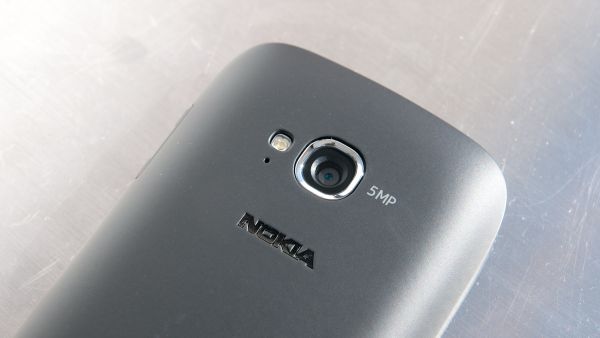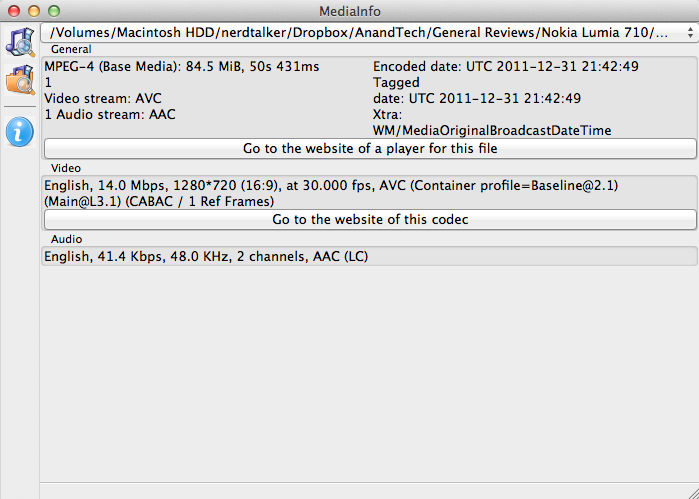Nokia Lumia 710 Review - T-Mobile's Nokia WP7
by Brian Klug on January 5, 2012 12:01 AM EST- Posted in
- Smartphones
- Nokia
- Mobile
- WP7
- Lumia 710
Camera - Stills and Video
The 710 uses a completely new F/2.4 optical system for Nokia in conjunction with a 5 MP CMOS and rear facing single LED flash. The system has a wide 35mm equivalent focal length of 28mm (and thus the same field of view as the Lumia 800), though it doesn’t carry Carl Zeiss branding.
Camera OSD controls inside WP7 are almost exactly the same as the Lumia 800, which now save and remain persistent across shooting sessions. Those controls are: scenes, white balance, exposure value, ISO, metering mode, effects, contrast, saturation, focus mode, resolution, and flicker reduction. Just like the 800 the 710 offers you the ability to shoot in either 4:3 or 16:9, but doesn’t have the neat ability to accomplish this by not just chopping pixels off the top and bottom. Instead, the 710 shoots at either 5 MP 2592x1944 (4:3) or 4 MP 2592x1458 (16:9) which is really more like 3.7 MP.

The 710, like every Windows Phone, has a two step camera button, but as I mentioned earlier I found the first detent extremely difficult to locate when pressed. I’m not sure whether this is just a manufacturing errata affecting just my device, or something that will be present on every 710. This does makes shooting difficult since WP7 will capture immediately when the button is pressed all the way down - even if the AF routine isn’t finished. Alternatively you can tap to focus (and capture) which is how I ended up getting most of my camera samples done.
To evaluate the Lumia 710’s camera, we turned to our lightbox tests with the lights on and off, outdoor testing at our test locations, and the new semi-revamped camera tests with the ISO12233, distortion, and color checker charts.
In the lightbox test with the lights on, the camera seems to have some issues (just like the Lumia 800) with white balance, producing an image with a definitely reddish cast. Something about the lights in the lightbox and Qualcomm’s ISP on the MSM8x55 generation of SoC definitely doesn’t get along, since I’ve now seen this behavior across HTC and Nokia devices. I don’t think it’s a fault of WP7 or Nokia after seeing this another time. Sharpness however is good, though I still feel that JPEG compression is turned up too high. For a 5 MP camera however, the 710 doesn’t look bad at all (jot that down as another tick under the 'megapixels don’t matter' column). With the lights turned off, we can see the differences between the white balance (which looks much better here) with the lights on. WP7 nicely fires a pre flash and illuminates the scene while focusing so we don’t miss focus even in the dark, and as a result we get a nice sharp image. The Lumia 710’s flash doesn’t have a super wide angle however, so there’s some falloff at the top and edges.
Turning to the new test bench, we can see some other good behavior out of the 710 camera which isn’t surprising. The white balance on the color checker card is actually not bad, though the colors themselves are a tad undersaturated. The 710 has a bit of barrel distortion (but so does every other smartphone camera) and actually comes out looking pretty good. Having only 5 MP to work with, we obviously see fewer spatial frequencies make it through to the picture in the ISO12233 chart - I can read up to around 12.5 in the saggital and tangential. You can also see that the 710 doesn’t do any insane oversharpening (no halos) here as well.
Next up are the outdoor tests at our smartphone test locations. As a reminder, tests 1 and 2 are no longer available, though 3 through 7 continue to get the job done. Subjectively I think the 710 comes out looking excellent here, with great dynamic range, contrast, and nice and sharp results. Again, my only complaint is that using the physical camera button produced some images where the 710 totally missed focus due to me not being able to tell where the focus detent was at all.
Video
Just like the Lumia 800, the 710 shoots 720p30 H.264 Baseline video at 14.0 Mbps. Audio is stereo AAC at 48 kHz 48 Kbps as well.
The 710 defaults to shooting 720p30 and not VGA, which is excellent. Curiously, the OSD sets the flicker compensation to 50 Hz for a model shipping on T-Mobile, in the US, where our power (and thus flicker from electric lights) is 60 Hz. We do our sample video shooting outdoors however, so this isn’t a huge concern.
Like the other Lumia, I think that the 710 ends up creating excellent quality 720p video. At this point, none of the Windows Phones are shooting 1080p video purely because none of the approved SoCs can encode 1080p video, so you can’t really hold that against the 710. I’ve also done the usual thing and uploaded the video to our own servers (88.6 MB) for you take a look at without any of YouTube’s transcoding.
















































48 Comments
View All Comments
PubFiction - Sunday, January 8, 2012 - link
Nokia may be working on their new core competency. Lots of companies do this same thing and roll just fine. Vizio, Apple to name a few. Do the design then outsource everything else.PubFiction - Sunday, January 8, 2012 - link
I should also add that nokia tried to make symbian work and they failed. They have gone from one of the worlds most recognised phone makers to almost nothing. I mean you can go into any phone provider in the US and I am not sure if you would see any nokia phones.So ya the whole making a competing OS in Europe thing just did not work out for them.
a5cent - Monday, January 9, 2012 - link
Symbian was not doomed due to it being developed in Europe. One of the main difficulties was that the developer was essentially a hardware company. Hardware and software development are very different, and requires a different company culture and different management. American hardware companies that attempt software almost always fail as well. Apple is probably the only exception... Apple is probably the worlds only systems company.Spivonious - Thursday, January 5, 2012 - link
Windows has poor multithreading? What are you talking about? Windows has supported multi-tasking (which is what I assume you mean, since only recently (last 5-10 years) have we gotten CPUs capable of operating more than one thread at a time) since Windows 1.0.WP7 has supported multi-tasking since launch. The API was opened up to 3rd party developers with the 7.5/Mango update.
As an owner of a WP7 phone and a user of iOS, Android, and RIM, I can veritably say that it is the best, most well-designed mobile OS out right now.
Apple doesn't make iPhones either. You may as well get over losing your factory job and realize that in the world economy, you make the product whereever you can get the best deal.
melgross - Thursday, January 5, 2012 - link
I haven't read past the first page yet, but the weights caught my eye. I don't know if the weight in grams is correct, or the weight in ounces, but there is a discrepancy.Assuming that grams is correct, the weight, in ounces, of the 800 should be 4.41, and the weight of the 710 is pretty close, but is then a bit more at 4.43.
jsv35 - Thursday, January 5, 2012 - link
Thank you for taking time and doing reviews on Windows Phone, it's always nice to see. I have an android device myself, but have always kind of liked the look of WP7zinfamous - Thursday, January 5, 2012 - link
Agreed.I don't follow the GPU and general hardware reviews as much as I used to, but the scope of those is what brought me to AT in the first place. I now see that same level of detail now with the phone reviews, and I would never purchase a phone without getting the skinny from AT first.
They have become the best on the web. Even the camera reviews are (were?) just as detailed at one time.
Kudos.
melgross - Thursday, January 5, 2012 - link
What I found interesting is that while neither the 800 or the 710 performed well, though as expected, the LCD screen of the 710 is MUCH brighter than the AMOLED screen of the 800, both phones performed much better than the extremely dismal performance of the N8, a phone which, for some unexplainable reason, is thought by some to be a super phone. To me, it seems a dud.kyuu - Thursday, January 5, 2012 - link
While integration/overlap with Windows on the PC and with the Xbox is certainly an interesting proposition and would be a boon, that's not what I (and probably a lot of others) are waiting for in order to jump ship to the Windows Phone platform. I love the WP UI, I love the *idea* (though not execution so far) of the controlled hardware platforms as opposed to Android's uncontrolled, fragmented mess and the singular, completely restricted iPhone platform.What I'm waiting for to jump are:
1) A more modern hardware platform. I understand all the arguments about why WP doesn't *need* a dual-core yadda yadda, but I have no interest in side-grading from my iPhone 4 to a hardware platform with pretty much exactly the same capabilities. I want an *upgrade* for my investment. And besides, when the hardware capability is there, the software that takes advantage of it will follow suit, and I've seen plenty of reports that 3rd-party Silverlight-based software does indeed suffer slowdown. I need at least a dual-core with a reasonably capable GPU.
2) I need an SD-card slot or some other way to increase the available storage. High-end devices with 8, 16, or even 32GB of NAND with no upgradability is simply not sufficient.
3) A quality screen with a pixel density that's at least competitive with what my iPhone 4 has. I don't want to downgrade to a screen that's looks worse.
I'm hoping by the end of this year with WP8 out, attractive hardware will be out so I can jump to the Windows Phone platform and never look back.
a5cent - Friday, January 6, 2012 - link
Excellent! I agree, and wonder how many other people feel similarly. I suspect you almost have to be a software developer to really appreciate the benefits of the controlled hardware platform. Microsoft's ability to guarantee that every WP device owner will get every update is one such benefit. However, other benefits that are more easily appreciated by end users have yet to materialize.I don't know about expandable storage, but we know the other issues will be resolved with WP8.
I'm also holding on to my current phone. I will also go for WP8 if:
a) we get very tight integration between W8 and WP8
b) we get some AAA applications and games directly from MS which make use of WP8 hardware